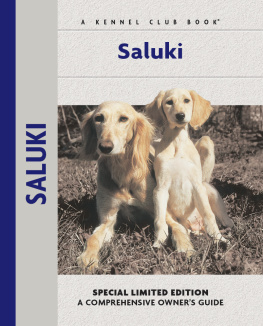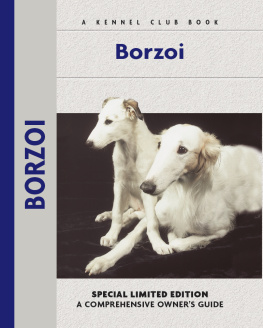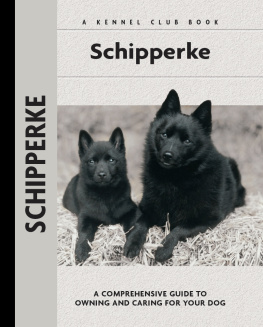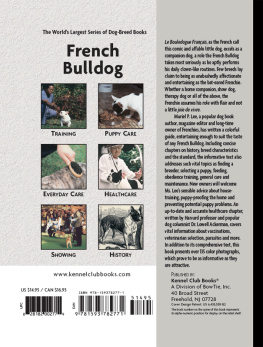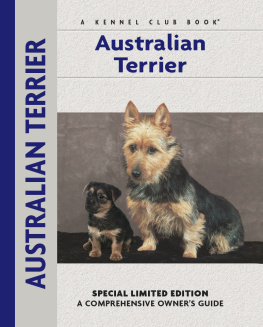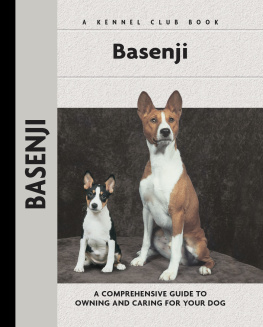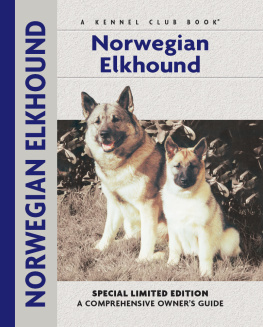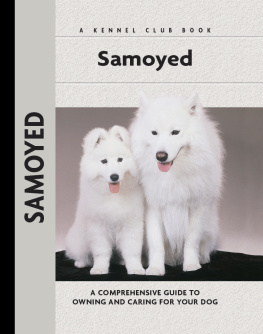Physical Characteristics of the Saluki
(from the American Kennel Club breed standard)
Head: Long and narrow, skull moderately wide between the ears.
Ears: Long and covered with long silky hair hanging close to the skull and mobile.
Eyes: Dark to hazel and bright; large and oval.
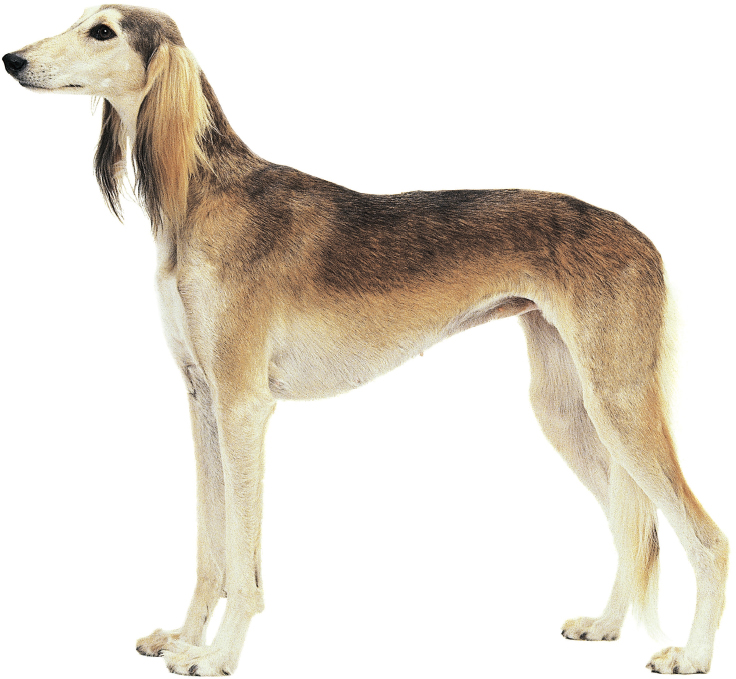
Nose: Black or liver.
Neck: Long, supple and well muscled.
Shoulders: Sloping and set well back, well muscled.
Chest: Deep and moderately narrow.
Forelegs: Straight and long from the elbow to the knee.
Colors: White, cream, fawn, golden, red, grizzle and tan, tricolor (white, black and tan) and black and tan.
Loin and Back: Back fairly broad, muscles slightly arched over loin.
Tail: Long, set on low and carried naturally in a curve.
Hindquarters: Strong, hipbones set well apart and stifle moderately bent, hocks low to the ground.
Feet: Of moderate length, toes long and well archedstrong and supple and well feathered between the toes.
Coat: Smooth and of a soft silky texture.
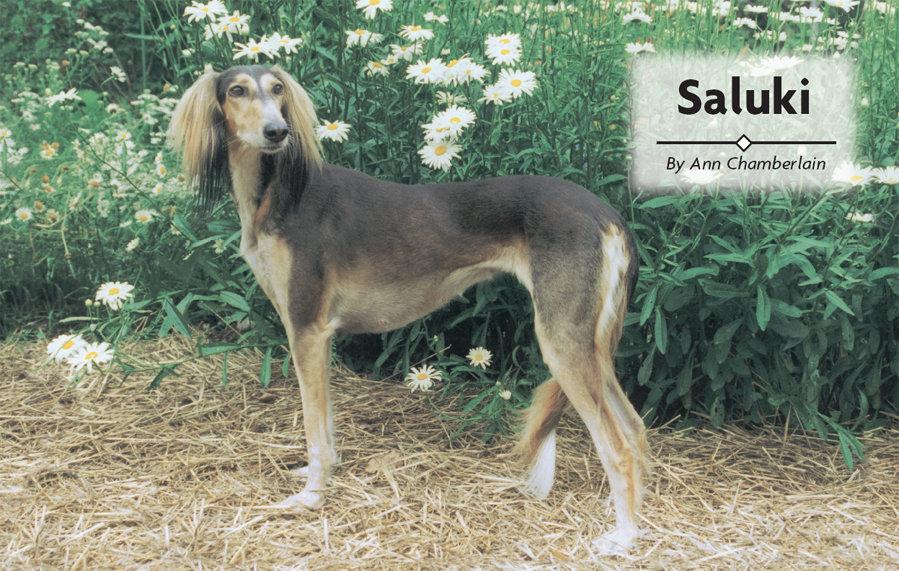
Contents

Sift through the sands of time to discover the true origins of the desert-bred wonder known as the Saluki. Meet the group of dogs that the author calls the Saluki Complex, view ancient artwork that places the breeds in Asia, Africa and beyond and learn about the breed in its native land. Follow the Salukis establishment outside its homeland, and see how this most ancient of breeds finds a place in the modern world.

Find out about the special qualities of the Saluki, including the breeds superior intelligence, excellent trainability, innate pack mentality, delicate temperament and health considerations. Discover whether you possess the right personality to be a Saluki person.

Learn the requirements of a well-bred Saluki by studying the various breed standards set forth through the years. Compare the breed standards of the American Kennel Club, the Fdration Cynologique Internationale, the Canadian Kennel Club and The Kennel Club of England. The author analyzes the Saluki standards from these registries and explains the differences, drawbacks and positives of each.

Find out about how to locate a well-bred Saluki puppy. Discover which questions to ask the breeder and what to expect when visiting the litter. Prepare for your puppy-accessory shopping spree. Also discussed are home safety, the first trip to the vet, socialization and solving basic puppy problems.

Cover the specifics of taking care of your Saluki every day: feeding for the puppy, adult and senior dog; grooming, including coat care, ears, eyes, nails and bathing; and exercise needs of your dog. Also discussed are the essentials of dog identification.

Begin with the basics of training the puppy and adult dog. Learn the principles of house-training the Saluki, including the use of crates and basic scent instincts. Get started by introducing the pup to his collar and leash and progress to the basic commands. Find out about obedience classes and other activities.

By Lowell Ackerman DVM, DACVD
Become your dogs healthcare advocate and a well-educated canine keeper. Select a skilled and able veterinarian. Discuss pet insurance, vaccinations and infectious diseases, the neuter/spay decision and a sensible, effective plan for parasite control, including fleas, ticks and worms.

Step into the center ring and find out about the world of showing pure-bred dogs. Heres how to get started in AKC shows, how they are organized and whats required for your dog to become a champion. Take a leap into the realms of obedience trials, agility, tracking, lure-coursing events and racing.

K ENNEL C LUB B OOKS S ALUKI
ISBN 13: 978-1-59378-300-6
eISBN 13: 978-1-62187-012-8
Copyright 2005 Kennel Club Books An Imprint of I-5 Press A Division of I-5 Publishing, LLC
3 Burroughs, Irvine, CA 92618 USA
Cover Design Patented: US 6,435,559 B2 Printed in South Korea
All rights reserved. No part of this book may be reproduced in any form, by photostat, scanner, microfilm, xerography or any other means, or incorporated into any information retrieval system, electronic or mechanical, without the written permission of the copyright owner.
10 9 8 7 6 5 4 3 2 1
Photography by Isabelle Franais, Frank Powers, Steve Surfman, Karen Taylor, Michael Trafford and Alice van Kempen.
with additional photographs by:
Mary Bloom, Paulette Braun, T.J. Calhoun, Alan and Sandy Carey, A. Jemolo, Carol Ann Johnson, Bill Jonas, Knemann Verlagsgesellschaft mbH, Kln, Alice Roche and Kent Standerford.
Illustrations by Patricia Peters.
The publisher wishes to thank all of the owners of the dogs featured in this book, including Helen Onto-Murphy, Frank & Winnie Powers, Joe & Pat Reese and Vickie Woods.
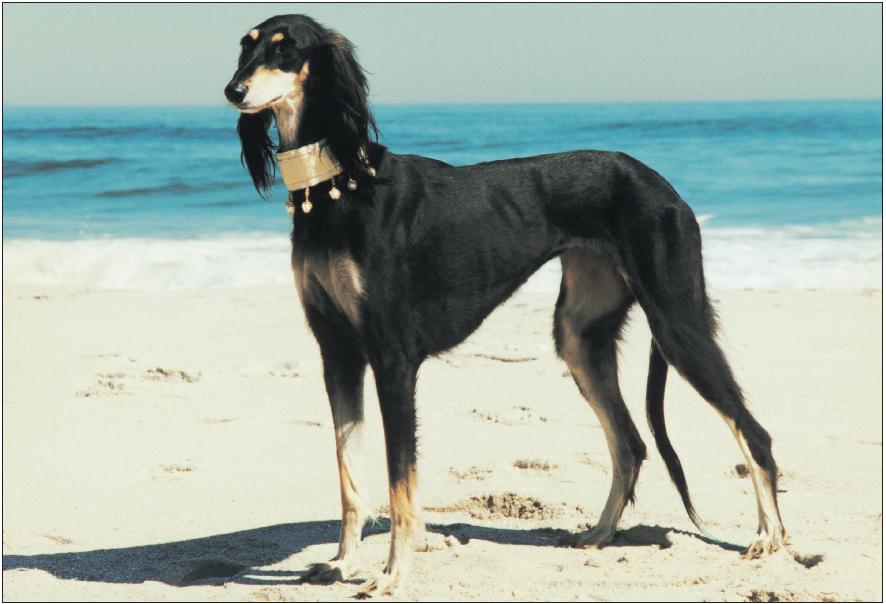
The origin of the Saluki is cloaked in mystery, legend and folktales. The breed, or the group of breeds very similar, has been recorded since the time of the Egyptian pharaohs.

ORIGIN OF THE SALUKI
Gift of Allah, Ancient of Ancients, El Hor, Al-Hurr, The Noble One. All of these phrases are used to describe the Saluki, a very ancient breed associated with nomadic tribes of the Near and Middle East, southwestern Asia and northern Africa. Today the Saluki is described as a separate breed, but I prefer to discuss the group of dogs that I would like to refer to as the Saluki Complex. There are many so-called breeds that resemble one another, originating from such diverse areas as the republics of the former USSR to the northwestern coast of Africa, even into the southern reaches of Africa, that it is obvious that the Saluki type has been known since time immemorial. Clearly, this dog was associated with man from the very beginning, although there are very interesting theories as to who domesticated whom! Some recent proposals put forth have indicated that the social lives of wolves and man interacted in such a way that one could almost say that wolves domesticated man! The concept of an Alpha figure seems to have contributed to the co-dependence between man and dog. Once the Alpha dog became subservient to the Alpha human, the dog-human connection was forged.

Next page
